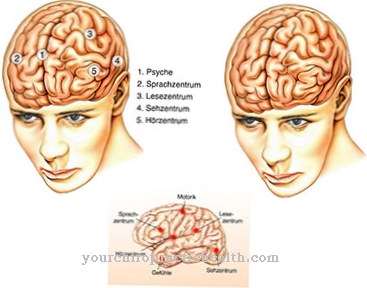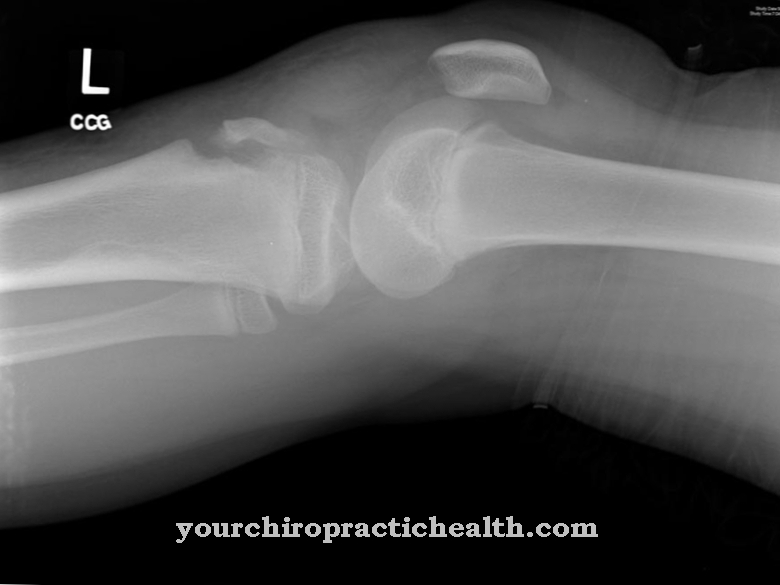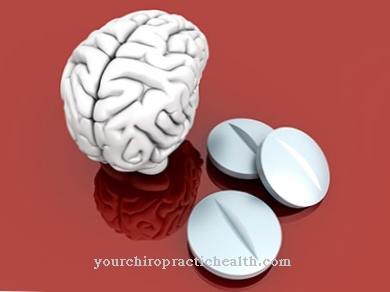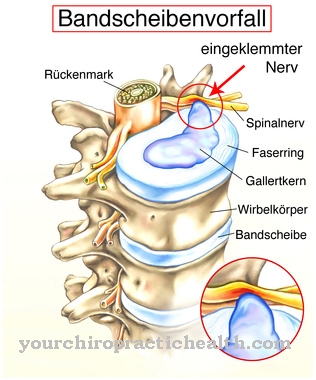As Soul blindness, also visual agnosia or optical agnosia, describes the inability to process sensory stimuli despite functional perception. The sense organs are not impaired and there is no mental illness such as dementia.
What is soul blindness?

© Henrie - stock.adobe.com
The difference to conventional blindness is that agnosia patients are not impaired in their vision.
They are unable to link visual perceptions with visual memories.
On Soul blindness sick people can see other people or objects, but cannot recognize them. However, acoustic and tactile perception is possible.
causes
This neurological disorder is caused by damage to the visual center, especially in the occipital lobe (occipital lobe, rearmost part of the cerebrum). Causes can be brain damage after an accident (head trauma) or a stroke. Apperceptive soul blindness prevents the various perceived elements from being combined into a coherent whole.
It occurs through damage to the early visual areas of the brain. Associative soul blindness always appears when one's own imagination cannot be brought together with information from other modes of perception. The sub-forms are described as imagination, object, symbol, and simultaneous agnosia. The question of why those affected cannot perceive faces and objects correctly even though their brain and eyes are completely intact has not yet been conclusively answered.
The brain is not able to correctly interpret the sensory impressions conveyed through the eyes. The sense of sight, also known as the sense of sight, is the most important human sense organ. The area in the brain that deals with the processing of the impressions delivered by the sense of sight is correspondingly large. If a person sees something in his environment, this visual information hits the eye, which forwards it to the brain. On the way there, this visual information passes around forty highly specialized brain areas.
The primary center of vision is in the back of the head. From this point two paths run through the brain, one extending to the temple and the other extending to the top of the head. The areas that are responsible for processing the incoming visual information are lined up on these paths. These areas are equipped with a large number of different nerve cells that respond to different visual stimuli. The neurons involved in this process prefer complex visual stimuli.
At the end of the hierarchical course, the groups of neurons respond specifically to known people or objects. A visual link exists not only within the visual areas, but also with more distant areas of the brain. All involved areas are in a lively exchange. When reading, for example, the visual areas work together with the language center.
Symptoms, ailments & signs
Neuropsychology deals with the phenomenon of this lack of face recognition. She tries to identify the place in the cerebral cortex that is responsible for recognizing geometric shapes. Magnetic resonance imaging studies show that the brain regions between the occipital and lateral lobes are responsible for facial perception.
Facial blindness occurs in isolation from other types of agnosia. Patients who have difficulty recognizing faces are still able to perceive the rest of their surroundings such as objects, trees, houses or the like. Facial agnosia is therefore not linked to object agnosia. For this reason, researchers assume that facial perception is a separate processing process in the brain. Brain research faces many unanswered questions, as the processes in the brain are far from being fully understood.
Brain researchers assume that the "fusiform gyrus" (cerebral convolutions), the brain region on the right side of the temple, controls the perception of faces. For this reason, science also calls this brain area the “fusiform face area” (FFA). The unusual phenomenon here is that a computed tomography does not show any abnormalities, although the corresponding modules that control this type of perception do not work for the face-blind.
Diagnosis & course of disease
The most prominent symptom is the inability to recognize faces.Those affected are unable to recognize the faces of people they know and identify them using familiar features such as voice, clothing, height or hair color (prosopagnosia). However, they are quite capable of recognizing objects, obstacles and other objects. If there is object blindness, objects in the environment are not properly perceived and those affected cannot, for example, draw pictures.
Since their imagination is not able to combine the incoming visual stimuli into a whole picture, they cannot name the faces or objects that are present. Typically, agnosia patients cannot remember faces or objects but have no difficulty describing these things from memory. Most patients can write but have difficulty reading due to the fact that the ability to write occurs from memory, but reading requires the perception of objects (letters).
The visual estimation ability (estimation of distances) and the ability to name colors are limited. Everything that those affected feel and hear is properly named (tactile agnosia). The doctors carry out various tests on the patients. For example, the patient has to identify objects and describe their use. In order to diagnose a visual field disorder, the patient is presented with photos of people known to him, whom he has to name. In addition, the general function of the eyesight is checked in order to rule out regular visual impairment or object agnosia.
Complications
Soul blindness has a very negative effect on the everyday life of the patient. In many cases the relatives or parents and friends of the patient are also affected by the disease and suffer from severe psychological complaints or depression. Due to the illness, patients can no longer perceive or classify people or objects correctly.
This results in significant restrictions in the everyday life of those affected, so that in many cases they also depend on the help of other people in their lives. Child development may also be restricted and significantly delayed by the disease. The further course of this disease depends very much on its exact cause, so that unfortunately no general prediction can be made about it.
As a rule, this disease cannot be treated directly. Most patients are dependent on various training sessions and therapies designed to promote memory. However, it cannot be predicted whether this will lead to a positive course of the disease. People may have to live with this condition their entire lives. Also, no statement can be made about life expectancy due to soul blindness. However, this is rarely restricted by the disease.
When should you go to the doctor?
In most cases of mental blindness, a doctor must be consulted. Self-healing cannot occur with this disease, so that those affected are usually always dependent on medical treatment. An early diagnosis of soul blindness has a positive effect on the further course of the disease. A doctor should be consulted if the person concerned shows changes in their behavior. The patients no longer recognize familiar faces, voices or smells or can no longer assign them correctly.
There is also severe depression or other psychological upsets. If these symptoms persist and do not go away on their own, a doctor must definitely be consulted. In most cases, soul blindness is treated by a psychologist. In severe cases, treatment in a closed clinic may be necessary. Since soul blindness is a largely unexplored disease, a universal course cannot be predicted.
Therapy & Treatment
Depending on the symptoms, complaints and findings, neurologists, speech therapists and occupational therapists take care of the patient. In addition to therapies that specifically promote speech and memory performance, simple measures such as motivated self-training for the patient can sometimes lead to success in order to make everyday life easier and to reduce embarrassing situations when a person is not recognized. The person concerned can train himself to perceive certain personal characteristics.
She can practice identifying the people around her by external and familiar characteristics such as voice, height, hairstyle, hair color, clothing style, figure and other individual characteristics. Pressure is removed from patients when they are open about their illness and inform those around them about this neurological disorder.
You can find your medication here
➔ Medicines against memory disorders and forgetfulnessprevention
Since even neurologists and brain researchers are not yet fully clear about how this neurological perception disorder develops, there is no preventive measure in the clinical sense that excludes a disease.
Aftercare
The disease has a significant impact on those affected. Known people and objects can often no longer be recognized. Likewise, those affected can no longer read. Those affected can no longer carry out simple everyday tasks independently. For this reason, the help of relatives and friends must be sought.
The disease can be very stressful for those affected. Therefore, it is recommended to visit a psychologist in addition to the neurologist. This can help those affected with dealing with the disease and the feelings it triggers. Sufferers should do whatever activities make them happy.
The best possible effort should be made to prevent depression. For example, you should do sports outdoors. This has a positive effect on the well-being of the sick. Exercise also supports the immune system. Likewise, the lifestyle should be adapted to the disease.
Eating a healthy diet and avoiding alcohol and nicotine has a positive effect on the disease. The diet should above all contain a lot of fruit and vegetables and fat and sugar should be avoided if possible. So that those affected can take the help of family members, they should be adequately informed about the disease. This can avoid unnecessary stress.
You can do that yourself
This rare form of cognitive disorder can affect anyone. Their impact on the social environment is fatal, however, as even people they know or everyday objects are no longer recognized. Other skills, such as reading, can also be impaired. Most of the time, the affected patients need help to cope with their everyday lives.
This can put a lot of strain on both those affected and their relatives. It is therefore advisable to consult a psychologist in addition to a neurologist for medical care. In addition, all measures that are known to prevent depression are recommended. Above all, this includes sport, especially if it is carried out outdoors. Fresh air and exercise not only support the immune system, but also bring balance and a good mood. At the same time, the patient has a sense of achievement that can compensate for the deficits of soul blindness.
The latest research shows that a healthy diet also has a positive impact on mental health. Soul blind patients do well not to smoke, drink alcohol, and avoid too much fat and sugar. Instead, they should resort to fruits, vegetables, whole grains, lean proteins and oils containing omega-3s.
It is also helpful for patients if they deal aggressively with their disease and inform those around them about any existing deficits. This prevents misunderstandings and can avoid unnecessary stress.


.jpg)

.jpg)









.jpg)













